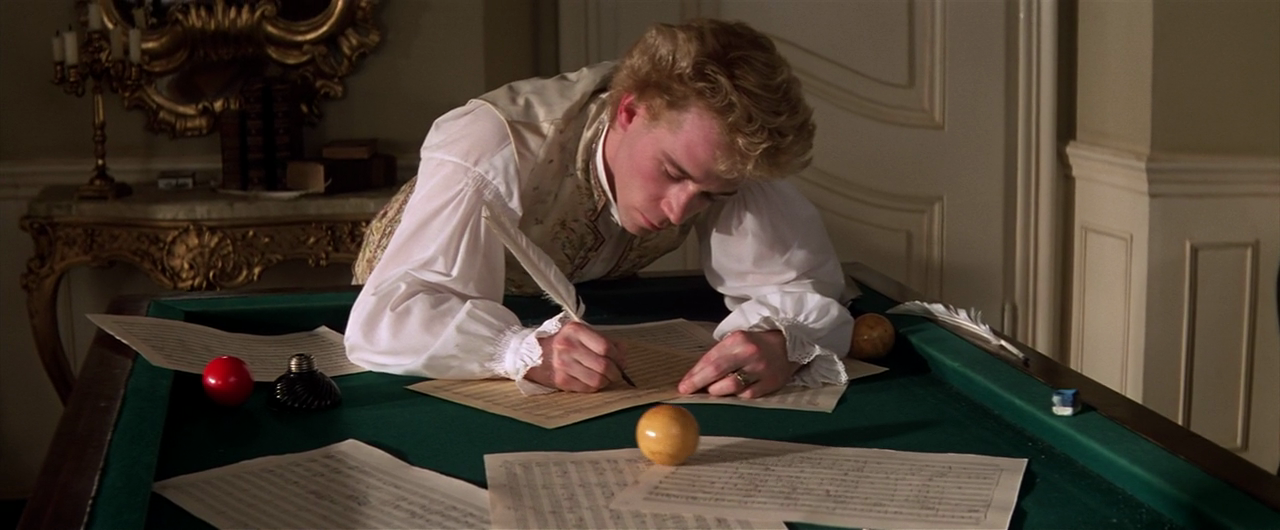Chamber Pot
Can there really be more after all that? Yes, yes there is. Mozart’s chamber music is a treasure trove of beauty and imagination. The clarinet quintet in particular has established itself as one of the greatest masterpieces of the entire chamber repertoire. Again, it is the sensitive treatment of the clarinet part and its exquisite interplay with the string quartet which gives the entire piece a luscious, bittersweet feeling throughout. A bit like expensive chocolate. The soothing quality of this work has actually brought people out of comas, has been used in speech therapy and is frequently played at both weddings and funerals. No, really. The slow movement is especially popular, but to me the first and fourth movements are most fun:
Clarinet Quintet, 1st Movement, Allegro:
Clarinet Quintet, 2nd Movement, Larghetto:
Clarinet Quintet, 3rd Movement, Menuetto:
Clarinet Quintet, 4th Movement, Allegretto with variations:
At this point yet another work with crucial significance in Amadeus comes up, the Gran Partita, a seven-movement serenade written for twelve wind instruments and a double bass. Its generous proportions allow for two minuets, which show off Mozart’s ability to write dance music, as well as a theme and variations, yet another famous slow movement, and a blistering finale. I have a bit of a bias towards wind instruments, but even so, this is an exceptional piece of music.
Gran Partita, 1st and 2nd movements, Largo – Allegro molto:
Gran Partita, 3rd movement, Menuetto:
Gran Partita, 4th and 5th movements, Adagio – Menuetto:
Gran Partita, 6th movement, Romance:
Gran Partita, 7th and 8th movements, Theme and Variations, Finale:
The consistently underrated string quartets are also worth delving into, especially Nos. 14-19, which Mozart dedicated to his friend, mentor and inventor of the form, Joseph Haydn, and are often referred to accordingly as the “Haydn quartets.” Aside from Haydn’s own many brilliant contributions to the genre (68 in all) this series represents the apex of classical quartet writing, before everyone else started messing around with it. Here are some selections:
Quartet No. 15, 4th movement, Allegretto:
Quartet No. 16, 3rd movement, Allegretto:
Quartet No. 17, 4th movement, Allegro assai:
The “Dissonance quartet” is particularly interesting because of the strange, slow introduction to the first movement which gives it its name. This was an incredibly daring piece of writing for its time, marking a key moment in musicians’ long obsession with deliberate discord, which resulted in all kinds of strange things in later centuries. The work was in fact so unusual that the publishers sent it back, asking for its “mistakes” to be corrected:
Quartet No. 19, 1st movement, Adagio – Allegro:
Quartet No. 19, 3rd movement, Allegretto:
Quartet No. 19, 4th movement, Allegro molto:
Aside from that, here are a few other highlights from Mozart’s chamber works, if you’re feeling adventurous. Mozart wrote for an astonishingly wide range of instruments, so if you’re stuck for a place to start, just pick an instrument you like the sound of and go from there:
The Piano Quartet No.1:
1st movement, Allegro
3rd movement, Rondo Allegro
String Quintet No.4 – with two violas!? Was he insane?!
1st movement, Allegro
Flute Quartet No. 1:
1st movement, Allegro
The Quintet for Piano and Wind Instruments:
2nd movement, Larghetto
The Oboe Quartet:
3rd movement, Rondo Allegro
The Horn Quintet:
3rd movement, Rondo
Pianissimo
Solo piano music was yet another string to Mozart’s bow. Here are a few selections of the best known pieces:
12 Variations on the French song “Ah, vous dirai-je, maman” – better known today as “Twinkle twinkle little star”:
The 11th Piano Sonata – the first movement of which is one of my favourite sets of variations on a theme. It has an incredible clarity and beauty, and gradually builds in intensity and complexity, allowing the listener to follow every modulation of the original melody with ease:
Piano Sonata No. 11, 1st movement, Andante Grazioso Part 1
Piano Sonata No. 11, 1st movement, Andante Grazioso Part 2
The third movement, which carries the direction “rondo alla turca,” is probably one of Mozart’s most famous compositions, despite the fact that it’s one of his least characteristic, because of its exoticism. It often gets confused with the equally non-Turkish march by Beethoven. I’ll be coming back to the idea of “alla turca” later, but for now, just listen:
Piano Sonata No. 11, 3rd movement, Rondo Alla Turca
If you had the misfortune to grow up with a sibling who played the piano, there’s also a good chance that you know the 16th piano sonata, nicknamed the “Facile” or “Easy” sonata, which was designed for teaching, and remains in use for that purpose:
Piano Sonata No. 16, 1st movement, Allegro
Piano Sonata No. 16, 2nd movement, Andante
Piano Sonata No. 16, 3rd movement, Rondo Allegretto
Here are some other memorable piano sonata movements:
Piano Sonata No. 13, 3rd movement, Allegretto
Piano Sonata No. 12, 3rd movement, Allegro assai
And last, but by no means least, the mercurial Fantasia no.3:



